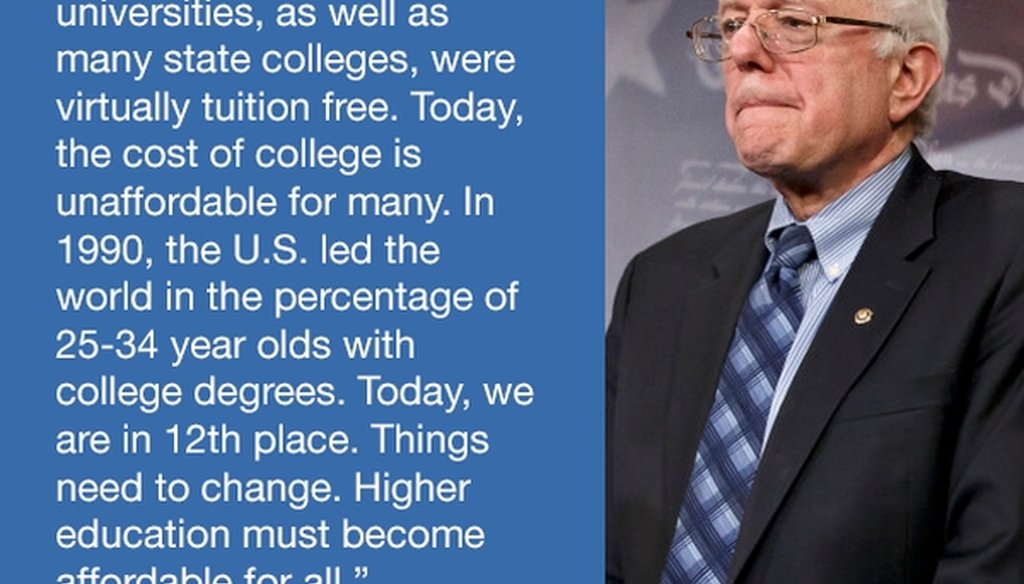

Our only agenda is to publish the truth so you can be an informed participant in democracy.
We need your help.


A reader asked us to check whether this social media meme from Sen. Bernie Sanders, I-Vt., is accurate.
Sen. Bernie Sanders, I-Vt., who has toyed with running for president in 2016, is a member of Congress who loves to share statistical claims on social media. Sometimes it’s on Twitter; other times it’s in memes tailored for Facebook.
A reader recently sent us a new meme featuring an image of the populist senator alongside a claim he made about higher education. It said:
"Forty years ago, some of our great public universities, as well as many state colleges, were virtually tuition free. Today, the cost of college is unaffordable for many. In 1990, the U.S. led the world in the percentage of 25-34 year olds with college degrees. Today we are in 12th place. Things need to change. Higher education must become affordable for all."
We decided to see whether Sanders was right that the United States led the world in 1990 for young people with college degrees but now ranks 12th internationally.
Checking the second part of the claim -- that the United States is currently in 12th place -- is pretty straightforward. It’s confirmed by statistics from the Organization for Economic Cooperation and Development, a group of advanced industrialized nations.
For 2012 -- the last year for which statistics are available -- there were 11 countries with higher rates of college education. According to OECD, the countries ranking higher than the United States were South Korea, Japan, Canada, Russia, Luxembourg, Ireland, United Kingdom, Australia, New Zealand, Israel, and Norway. The top finisher, South Korea, had a rate more than 20 percentage points higher than the United States.
We had more trouble finding data for 1990. When we asked Sanders’ staff for the source, they pointed us to a scholarly paper published by BBVA Research, titled, "Educational Attainment in the OECD, 1960-2010." In Table 14, the paper offers college attainment data for OECD countries for each five-year increment between 1960 and 2010.
However, this measurement is not exactly the same one as used in 2014. It looks at attainment of the "second cycle of higher education" in each country, which isn't exactly the same as rates of receiving an undergraduate degree. So this data does not allow for an apples-to-apples comparison.
The most direct comparison we could find was OECD data from 2000. That year, the United States ranked fourth after Canada, Japan and Finland.
It’s worth noting that two of the countries ranking ahead of the United States in 2012 -- Russia and Israel -- were not surveyed in 2000. So their inclusion in the 2012 data slightly exaggerates the severity of the U.S. decline.
Still, experts told PolitiFact that if you extrapolate back from the 2000 data to 1990, the United States was certainly among the highest ranks of countries in rates of college degrees.
"There could be some niceties to quibble with, but probably nothing that would make his statement wrong in any significant way," said David Bills, an education professor at the University of Iowa. "The statement is generally accurate."
Bills and other experts did question whether there’s a straight-line link between high tuition and low degree rates, as Sanders argued.
"My guess -- and it’s mostly a guess -- is that students being academically underprepared leads to more noncompletion than tuition does," Bills said.
Ben Wildavsky, director of higher education studies at the Rockefeller Institute of Government, concurred.
"The key thing to understand is that U.S. degree-attainment rates haven’t gotten worse – the rest of the world has gotten better," Wildavsky said. "So this doesn’t particularly say anything about affordability, I think. But it’s reasonable to say that we need to increase degree production to meet the needs of the changing economy."
Our ruling
Sanders said that "in 1990, the U.S. led the world in the percentage of 25-34 year olds with college degrees. Today we are in 12th place."
There are some quirks in the data, but experts agree that the general trend line is roughly as Sanders says it is. The statement is accurate but needs clarification or additional information, so we rate it Mostly True.
Bernie Sanders, meme, December 2014
Organization for Economic Cooperation and Development, "Education at a Glance 2014," accessed Dec. 5, 2014
BBVA Research, "Educational Attainment in the OECD, 1960-2010," Sept 17, 2012
White House, "Increasing College Opportunity for Low-Income Students," January 2014
PolitiFact Ohio, "Arne Duncan says the U.S. has dropped from No. 1 to No. 16 in the world for college graduation," Jan. 20, 2012
Email interview with David Bills, education professor at the University of Iowa, Dec. 3, 2014
Email interview with Ben Wildavsky, director of higher education studies at the Rockefeller Institute of Government, Dec. 3, 2014
Email interview with Michael Briggs, spokesman for Bernie Sanders, Dec. 3, 2014
In a world of wild talk and fake news, help us stand up for the facts.
